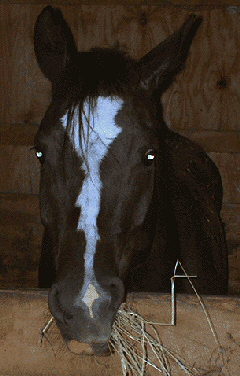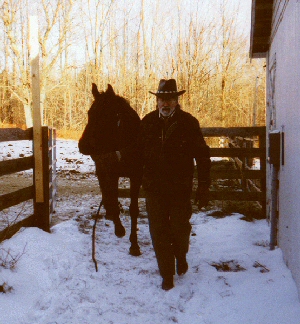Return to Questions and Answers Index
Q&A
Questions and Answers:
QUESTION:
 I have a four year old paint mare that I got due to a death of a friend a few months ago. Here is the problem that I have... she gets VERY upset when it is time to turn out the horses and she is still in her stall. The place that I board her at will go and turn the horses out and as soon as the first horse leaves the arena she will start pacing the stall, pawing the door and even get to the point of rearing in her stall. When you open the door she will try and shove you out of the way so that she can get outside. At the place where she was at before this is how the owner handled turn out: She would shut the back barn door and open the pasture gate and let the horses out of the stall and allow them to run through the front door to the pasture. When it was time to turn out, ALL the horses were let out every time.
I have a four year old paint mare that I got due to a death of a friend a few months ago. Here is the problem that I have... she gets VERY upset when it is time to turn out the horses and she is still in her stall. The place that I board her at will go and turn the horses out and as soon as the first horse leaves the arena she will start pacing the stall, pawing the door and even get to the point of rearing in her stall. When you open the door she will try and shove you out of the way so that she can get outside. At the place where she was at before this is how the owner handled turn out: She would shut the back barn door and open the pasture gate and let the horses out of the stall and allow them to run through the front door to the pasture. When it was time to turn out, ALL the horses were let out every time.
Now that I have had her I have tried tying her in the stall and making her wait until all the other horses are out and then letting her out only AFTER she has settled down a little. We are now at least to the point that when I walk into her stall and untie her and open the door she will not run out, she will paw the ground (half the time hitting the wall hard with her hoof or the water bucket with her knee) but she will not run out until I tell her that she can come out and she will walk calmly. My main concern is that I don't like her rearing up in her stall, even though she will not do that when I am in the stall with her. She has NEVER tried to bite, kick, buck and once we shut the door and start to work she is just fine under saddle. Any help or ideas that you can give to help me with this would be great.
I think that your site has been very helpful with the training of my other two horses.
-- C. V.
ANSWER:
I don't think the problem is as bad as it seems to you. The key is that horses are VERY relationship oriented.
Let me give you an example that, at first glance, won't seem at all similar to your situation. This past spring, I went out to see Fanny just as our first thunderstorm of the season rolled in. Fanny was more upset than I'd ever seen her before, and when I tried to approach her she first turned her rear end to me and then walked out of the run-in and paced around in the paddock. I eventually was able to take her by the halter, calm her down, and walk her back into the shelter. I'd never seen her act like this and it took a while to puzzle it out. Suddenly, it hit me. This was the first thunderstorm in her entire life when she didn't have Willy with her. Willy died last December, and he had been part of her security for as long as she could remember. Now he wasn't there to reassure her that things were all right.
Now, apply that to your paint. Her former human "lead brood mare" is no longer around, and when the other horses are let out she is left by her very vulnerable self. On top of that, she was trained to believe that the proper herd procedure was for the entire herd to move out together. In other words, her entire life has been torn apart and a bunch of the rules she lived by no longer apply. No wonder she gets upset.
So, how do you correct the situation?
Go back to basics and help her learn the new rules.
Rule Number One: You (the human) are her new lead brood mare. This lesson will be taught in the round pen, on the longe line, and under saddle. It will also be taught when you move her in and out of the stall. If she doesn't walk calmly with you, turn her around, go back into the stall, make her stand, and then exit the stall again. (I assume you're using a halter and lead rope when you let her out.) Do this as often as needed, giving her plenty of positive feed-back when she behaves well (or even just better than before). And repeat the process when she comes in at night.
Rule Number Two: Humans are always more important than horses. No matter what the other horses are doing, if there is a human present, that's where the horse's attention must focus. Again, you're really going back to the basics. Whenever her attention drifts to the rest of the herd, give her some cue or command that brings her mind back to you.
 I know that some folks think I'm much too easy on the horses (I've even been called a "push-over") but they don't argue with the results. If you take the time to try to understand things from the horse's point of view, the outcome is usually a lot better.
I know that some folks think I'm much too easy on the horses (I've even been called a "push-over") but they don't argue with the results. If you take the time to try to understand things from the horse's point of view, the outcome is usually a lot better.
To the right is a snapshot my wife took when I was horse-sitting at a neighbor's place. It's a bit hard to see the details, so I'll try to describe it. The mare I'm leading used to bolt from the stall whenever the other horses were let out first. When coming in at night, she'd try to push through the pasture gate and run into the barn. It only took a few days of the sort of obedience training I've outlined under Rule Number One before she was doing it right -- "heeling" just like an over-grown hunting dog. Eventually, I had that mare walking so politely that I didn't even connect the lead rope to her halter -- I'd just drape the lead loosely around her neck, as you can see from the way it's dangling in the picture.
Previous Question
| Next Question
 Return to Questions and Answers Index
Return to Questions and Answers Index
 Return to the "Learning More About Horses..." page
Return to the "Learning More About Horses..." page
COPYRIGHT © 2006 BOB LEMEN, GRAND RAPIDS,
MINNESOTA. ALL RIGHTS RESERVED.
The contents of this document are not for reproduction.
 I have a four year old paint mare that I got due to a death of a friend a few months ago. Here is the problem that I have... she gets VERY upset when it is time to turn out the horses and she is still in her stall. The place that I board her at will go and turn the horses out and as soon as the first horse leaves the arena she will start pacing the stall, pawing the door and even get to the point of rearing in her stall. When you open the door she will try and shove you out of the way so that she can get outside. At the place where she was at before this is how the owner handled turn out: She would shut the back barn door and open the pasture gate and let the horses out of the stall and allow them to run through the front door to the pasture. When it was time to turn out, ALL the horses were let out every time.
I have a four year old paint mare that I got due to a death of a friend a few months ago. Here is the problem that I have... she gets VERY upset when it is time to turn out the horses and she is still in her stall. The place that I board her at will go and turn the horses out and as soon as the first horse leaves the arena she will start pacing the stall, pawing the door and even get to the point of rearing in her stall. When you open the door she will try and shove you out of the way so that she can get outside. At the place where she was at before this is how the owner handled turn out: She would shut the back barn door and open the pasture gate and let the horses out of the stall and allow them to run through the front door to the pasture. When it was time to turn out, ALL the horses were let out every time.
 I know that some folks think I'm much too easy on the horses (I've even been called a "push-over") but they don't argue with the results. If you take the time to try to understand things from the horse's point of view, the outcome is usually a lot better.
I know that some folks think I'm much too easy on the horses (I've even been called a "push-over") but they don't argue with the results. If you take the time to try to understand things from the horse's point of view, the outcome is usually a lot better.